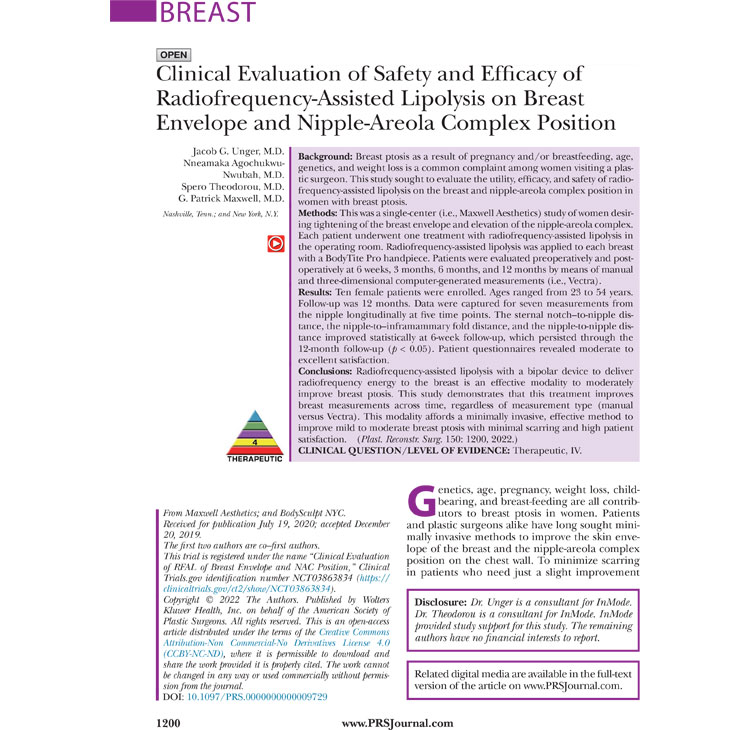Breast ptosis or saggy breasts is a common aesthetic concern that occurs as a result of pregnancy and/or breastfeeding, age, genetics, and weight loss. Many women seek breast lift surgery in New York City to correct sagging and improve contour. Mastopexy or breast lift surgery raises the nipple-areola complex to a more aesthetically pleasing position by removing excess skin and tightening the surrounding tissue. Plastic surgeons use different types of surgical and nonsurgial techniques and incisions to perform the procedure, based on individual considerations such as the extent of sagging, nipple symmetry, and desired results. A recent study evaluated the utility, efficacy, and safety of InMode’s BodyTite radiofrequency-assisted lipolysis to address breast ptosis.

The new study titled “Clinical Evaluation of Safety and Efficacy of Radiofrequency-Assisted Lipolysis on Breast Envelope and Nipple-Areola Complex Position” was published in Plast. Reconstr. Surg. (150: 1200, 2022). Dr. Spero Theodorou (Plastic Surgeon, bodySCULPT NYC and consultant for InMode, is one of the authors of the study.
A breast lift is an ideal option for women who experience the following concerns:
- Breasts that have lost shape and volume, or have become flatter and longer
- Nipples fall below the breast creases, when the breast is unsupported
- Nipples and areolae point downward
- The areolae have stretched out of proportion
- One breasts falls lower than the other
Studies have found that BodyTite radiofrequency-assisted lipolysis is an effective option for contouring of the arms, neck, lower face, abdomen, medial thighs, and chest in male patients with gynecomastia. This new study is the first to describe radiofrequency-assisted lipolysis for treatment of breast ptosis or for improvement of the nipple-areola complex position and the overall breast envelope. The BodyTite (BreastTite) device applies electromagnetic radiation directly to the soft tissues to stimulate skin contraction and collagen formation.
The researchers evaluated 10 female patients, ages 23 to 54 years, who desired tightening of the breast envelope and elevation of the nipple-areola complex. The patients underwent radiofrequency-assisted lipolysis on the breast and nipple-areola complex position using the BreastTite device at Maxwell Aesthetics, an AAAAF-accredited plastic surgery center.
Each patient had one radiofrequency-assisted lipolysis treatment session in the operating room. Some participants received general anesthesia and the rest received local anesthesia. The BodyTite Pro handpiece was used to perform radiofrequency-assisted lipolysis on each breast. Data were collected for seven measurements from the nipple longitudinally at five time points: baseline, 6-week follow-up, 3-month follow-up, 6-month follow-up, and 12-month follow-up. The patients were evaluated preoperatively and postoperatively at these time-points using manual and three-dimensional computer-generated (Vectra technology) measurements.
The study found that the treatment improved “sternal notch–to-nipple distance, the nipple-to–inframammary fold distance, and the nipple-to-nipple distance improved statistically at 6-week follow-up, which persisted through the 12-month follow-up”. The authors concluded that BodyTite radiofrequency-assisted lipolysis is an effective minimally invasive method to improve mild to moderate breast ptosis with minimal scarring and high patient satisfaction.
bodySCULPT surgeons Dr Spero Theodorou and Dr Christopher Chia have authored several studies on the use of radiofrequency technology in cosmetic treatments.
For more information, please download the PDF by clicking on the link below.
Clinical Evaluation of Safety and Efficacy of Radio-Frequency Assisted Lipolysis on Breast Envelope and Nipple-Areola Complex Position
Jacob G. Unger, M.D., Nneamaka AgochukwuNwubah, M.D., Spero Theodorou, M.D., G. Patrick Maxwell, M.D. Plastic and Reconstructive Surgery. Volume 150, Number 6, December 2022
